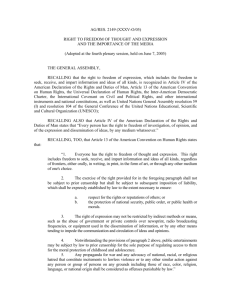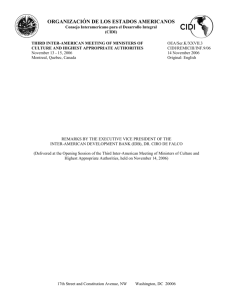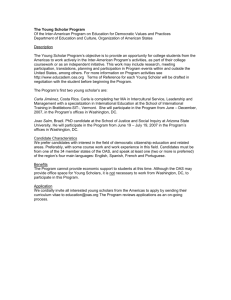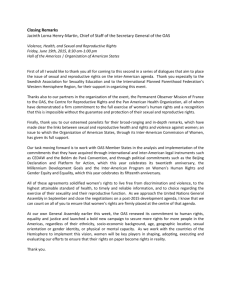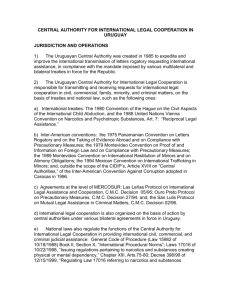Lecture 7 Inter
advertisement
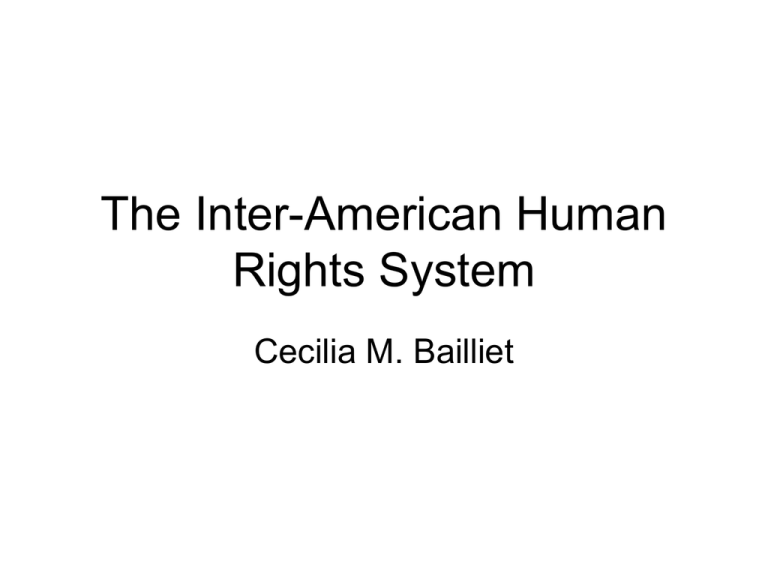
The Inter-American Human Rights System Cecilia M. Bailliet OAS Charter- Principles Art 1 • • • • • • • • • To promote Representative Democracy Economic, Social, and Cultural Development Eradicate Poverty Education Peace & Equality, Non-Discrimination (race. Nationality, creed or sex) Pacific Settlement of Disputes, Justice, Freedom Respect for Non-Intervention Defense of Territorial Integrity, Sovereignty and Independence Limit conventional weapons American Declaration • Adopted before the Universal Declaration of Human Rights- first intl. statement of human rights • Inter-American Court and Commission have held that it is now a source of legal obligation for OAS member states (USA disagrees) American Convention on Human Rights • Empowers the Inter-American Commission on Human Rights & InterAmerican Court of Human Rights as compliance mechanisms • 24 of 35 OAS member states are parties (not ratified by USA, Belize, Canada, Suriname, denounced by Trinidad and Tobago) Inter-American Commission of Human Rights Inter-American Court of Human Rights Other Inter-American Instruments • • • • • • • • • Protocol on Economic, Social and Cultural Rights Protocol to Abolish the Death Penalty Convention to Prevent and Punish Torture Convention on Forced Disappearance of Persons Convention on the the Prevention, Punishment and Eradication of Violence Against Women Convention on the Elimination of All Forms of Discrimination Against Persons with Disabilities Inter-American Declaration of Principles on Freedom of Expression Principles and Best Practices on the Protection of Persons Deprived of Liberty in the Americas Inter-American Democratic Charter Activity: • Please compare the American Convention and Declaration. • What type of rights are identified in each? • What is the wording with respect to the scope of duty of the state towards implementation of the rights • Look at Article 26 in the Convention. Right of Petition • Individuals (+ any person, group or NGO, victim or third party with or without the victim’s knowledge) have right of petitionmay file complaint against the State upon its ratification of the American Convention • State must make an express declaration recognizing the competence of the Commission to deal with complaints from other States Inter-American Commission of Human Rights • • • • Seeks information- Prepares Country Specific Reports Receives Individual Petitions Engages in Fact Finding, on site visits Friendly Settlement (if not reached, Commission may refer Case to the Court) • Attribution of State Responsibility- Issue Recommendations to the State (Soft Law) • Publish report in the event of non-compliance by the State • State may challenge this by appealing case to the InterAmerican Court of Human Rights Inter-American Commission on Human Rights • Reports and Recommendations address state responsibility for forced disappearances, domestic violence, third party infringement of indigenous property, arbitrary detention in counter-terrorism, violation of due process of migrants, environmental damages, etc. Preliminary Objections • • • • Ratione Materie Ratione Personae Loci Ratione Temporis- ”Continuing Violations” in cases involving forced disappearance (Blake Case), denial of the right to citizenship (Yean v. Dom. Rep.), deprivation of the right to property (Moiwana Community Case), and denial of effective recourse- state failure to investigate and prosecute human rights violations (Blake Case). Exhaustion of Domestic Remedies & Right to Effective Recourse • Exception when this is impossible due to lack of due process rights in domestic institutions, denied access to institutions, or delay in receiving decision from institutions. • Article 8 (Fair Trial) and Article 25 (Judicial Protection) require effective recourse for human rights violations via effective, investigation, prosecution and punishment of those responsible. The right belongs to victims and their families. Denial of recourse may constitute ”continuing violation” (Moiwana community v. Suriname) State Responsibility & Jurisdiction • Violations via direct act or failure to prevent an act by a Non-State actor • Failure to investigate and sanction those responsible • Jurisdiction is not limited to the physical territory of the state, it includes all areas over which it has effective control. See 2002 Letter from IACHR president to US Secretary of State on Guantanamo Bay Inter-American Special Rapporteurs • • • • • • • • Freedom of Expression Migrant Workers & their Families Rights of Women The Rights of the Child Prisoners Persons of African Descent Indigenous Peoples Human Rights Defenders Sources of Evolutionary Interpreation • Vienna Convention on the Law of Treaties • Court’s own normative reasoning • Human Rights treaties have the objective norm of protection of the individual, not reciprocity between states • Treaty terms are given autonomous meaning within their context (not left to each state to decide according to national law) Sources of Normative Reasoning • Mankind’s universality and the universality of the rights and freedoms which are entitled to protection from the core of all international protective systems • Corpus juris of international human rights law : set of international instruments (treaties, conventions, resolutions and declarations) Sources of Interpretation • American Conv. Art. 29 (b) No provision of this convention shall be interpreted as restricting the enjoyment or exercise of any right or freedom recognized by virtue of the laws of any State Party or by virtue of another Convention to which one of the said states is a party. • Reference to other OAS human rights instruments, in Castro Castro Prison Case consult Convention of Belem on Violence against Women, and in Street children case address Convention on the Rights to the Child. • UN and European human rights instruments (hard and soft) and jurisprudence. • European jurisprudence in defamation case (Herrera Ulloa Case), scrutiny of politicians (Ricardo Canese Case). • UN HRC in case involving right to appeal a criminal conviction on facts. • UN Guiding Principles on Internal Displacement (Moiwana Case) • UN Body of Principles of the Protection of All Persons under Detention (Tibi Case). • UN Manual on Effective Protection of Extra Legal Arbitrary and Summary Executions (Juan Humberto Sanchez Case) Inter-American Court of Human Rights: Art. 62 Contentious Jurisdiction • Victims may participate in proceedings • Issues legally binding decisions (including reparations) on state responsibility • Issues provisional measure orders (threat to life and physical integrity of individuals and communities, protect prisoners and children in detention centres) • Publishes compliance with judgment reports • Impunity: Problems with delays in payment of reparation, faulty implementation of orders to investigate, prosecute and punish the individuals responsible Inter American Court of Human Rights • Time of processing of complaint from submission to the Court is over 8 years • Lack of funding is a problem • States acquiesce or acknowledge partial or total international responsibility in 42% cases • States paid compensation to victims in 81% of cases Lower standard of proof • Disappearances can be proven by circumstantial evidence and logical inference after the Commission has established a pattern of disappearances linked to indivdiual case by circumstantial evidence. Burden shifts to the state to prove that it was not responsible for the disappearance. Inter-American Court of Human Rights- Normative Evolution • Transcendental Rights: Right to Dignity in Life (Sawhoyamaxa Case, Street Children Case, Juvenile Reeducation Case), Right to Truth, Right to Life’s Project • Freedom of expression, criminal defamation against public officials • Recognition of justiciability of socio-economic rights, link to civil and political rights Duty of protection of elderly, children, pregnant women, grant of health care, clean water and food to indigenous people (Yakye Axa Indigenous Community Case) • • Jus cogens recognition: prohibition of slavery, physical and psychological torture, forced disappearance, extra-judicial execution, inhumane treatment, crimes against humanity, statute of limitations for crimes against humanity, failure to punish perpetrators of crimes againt humanity, right of access to justice, non-discrimination • First international recognition of right to communal property (Awas Tingi Case, Saramanka People Case, Moiwana Community Case) • Recognize legal capacity of indigenous people to have rights recognized • Seeks creation of an international ordre publique based on respect of human rights in all circumstances Reparations • Financial Compensation • Equitable Reparation• Legislative reform or repeal (amnesty laws in Argentina), education and human rights training of state officials, development projects, erection of monuments with names of victims, publication of books or translation of judgments, commemoration of victims, creation of schools, cultural projects, provision of psychiatric or psychological assistance to victims, etc. • Compliance problems when ordering investigation, prosecution or punishment of offender • In 2005 Paraguay legislature voted against return of indigenous land to community in spite of Court order Inter-American Court of Human Rights: Advisory Opinions • Art. 64 OAS Member States and OAS Organs may request an advisory opinion regarding the interpretation of the Convention or other treaties. • Authoritative, but non-binding • Juridical Condition and Rights of Undocumented Migrants- Declared Non-discrimination to be a jus cogens nomr applicable de jure and de facto acts by private or public actors. • Consular Assistance, right to information on consular assistance recognized as an individual right of arrested person Advisory Opinion on Undocumented Migrants • Equality, Non-Discrimination and Equal Protection of the Law are part of one jus cogens principle • Cite 30 human rights instruments • Derived from oneness of the human family and linked to the essential dignity of the individual
